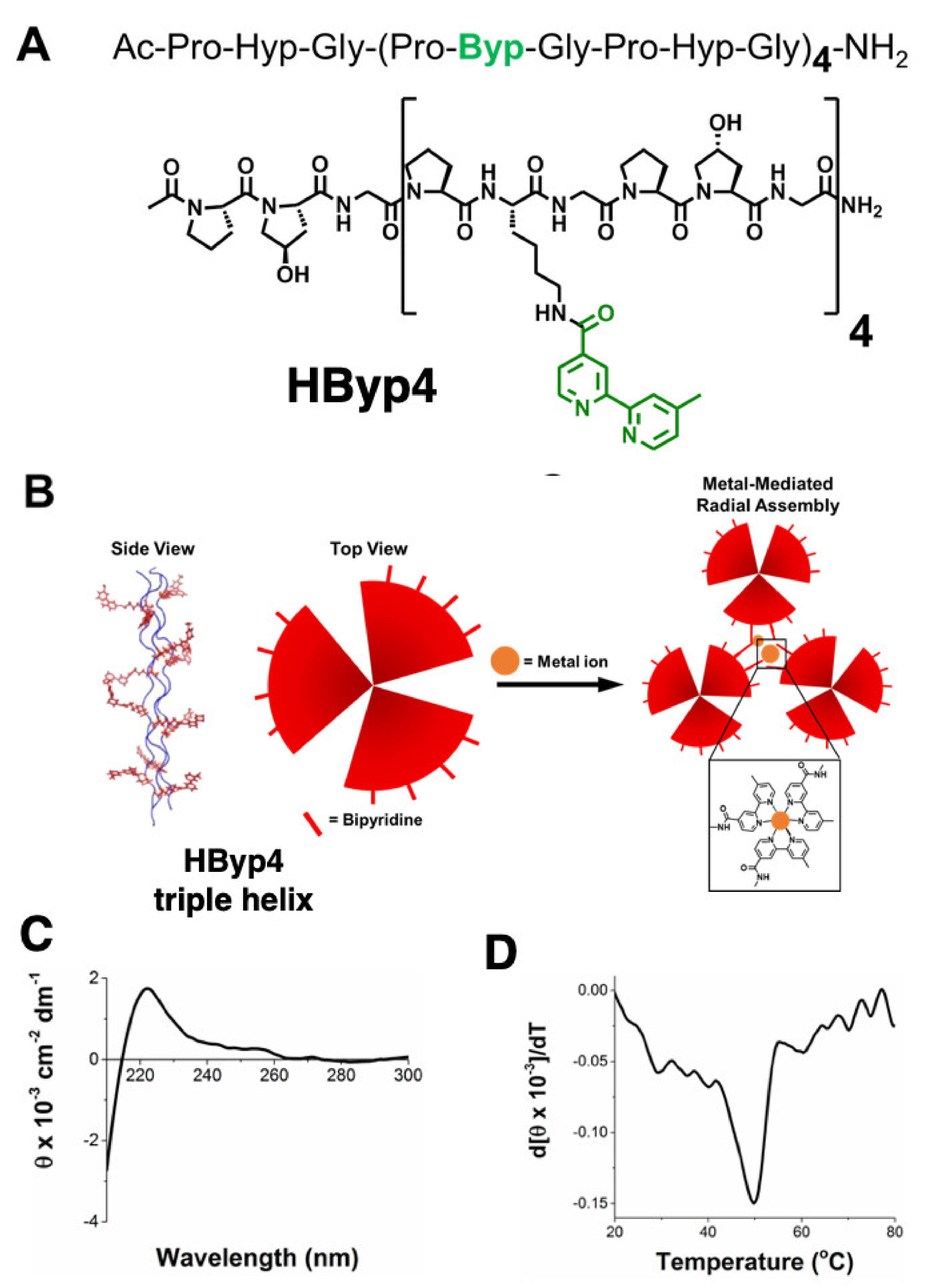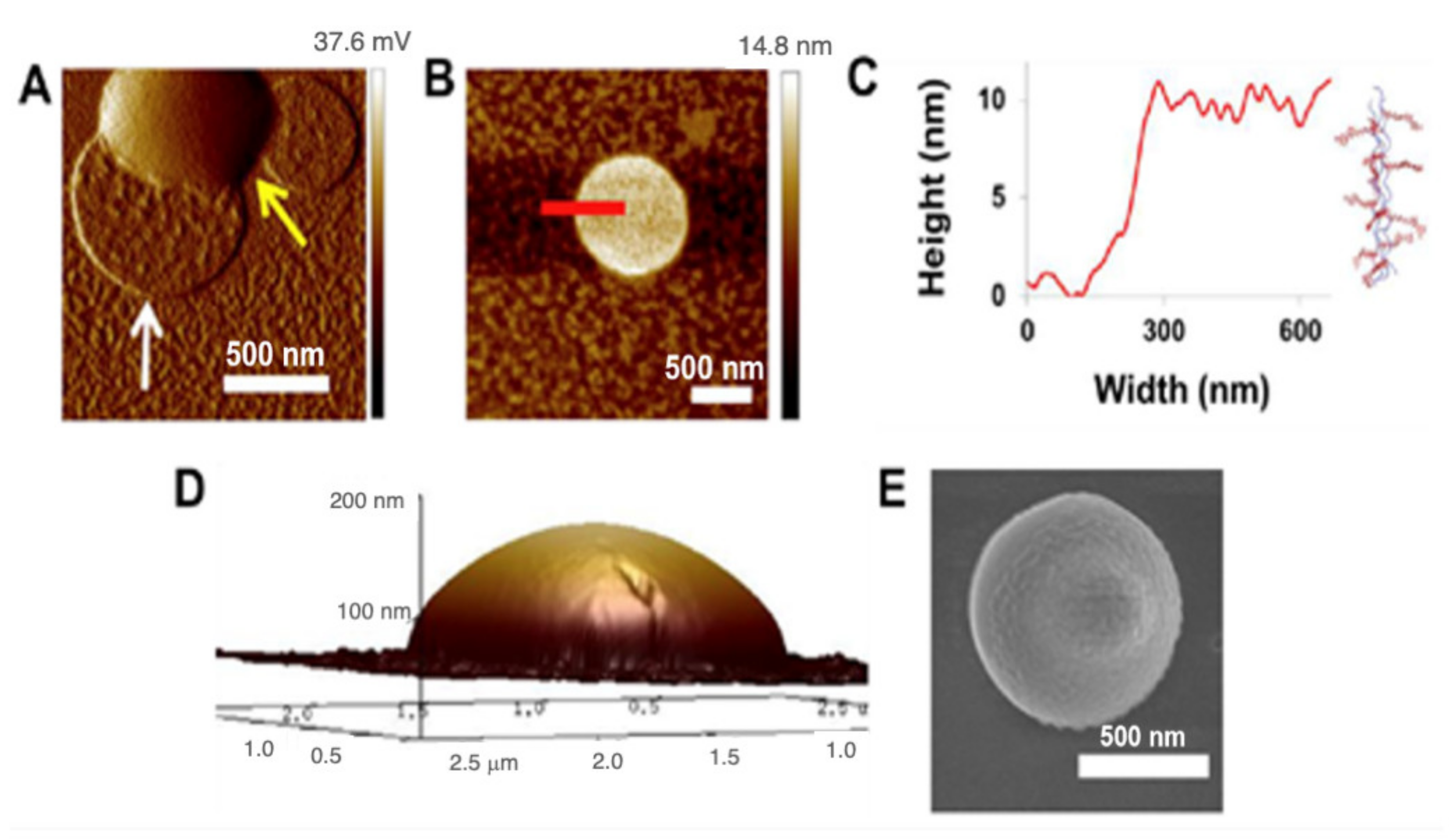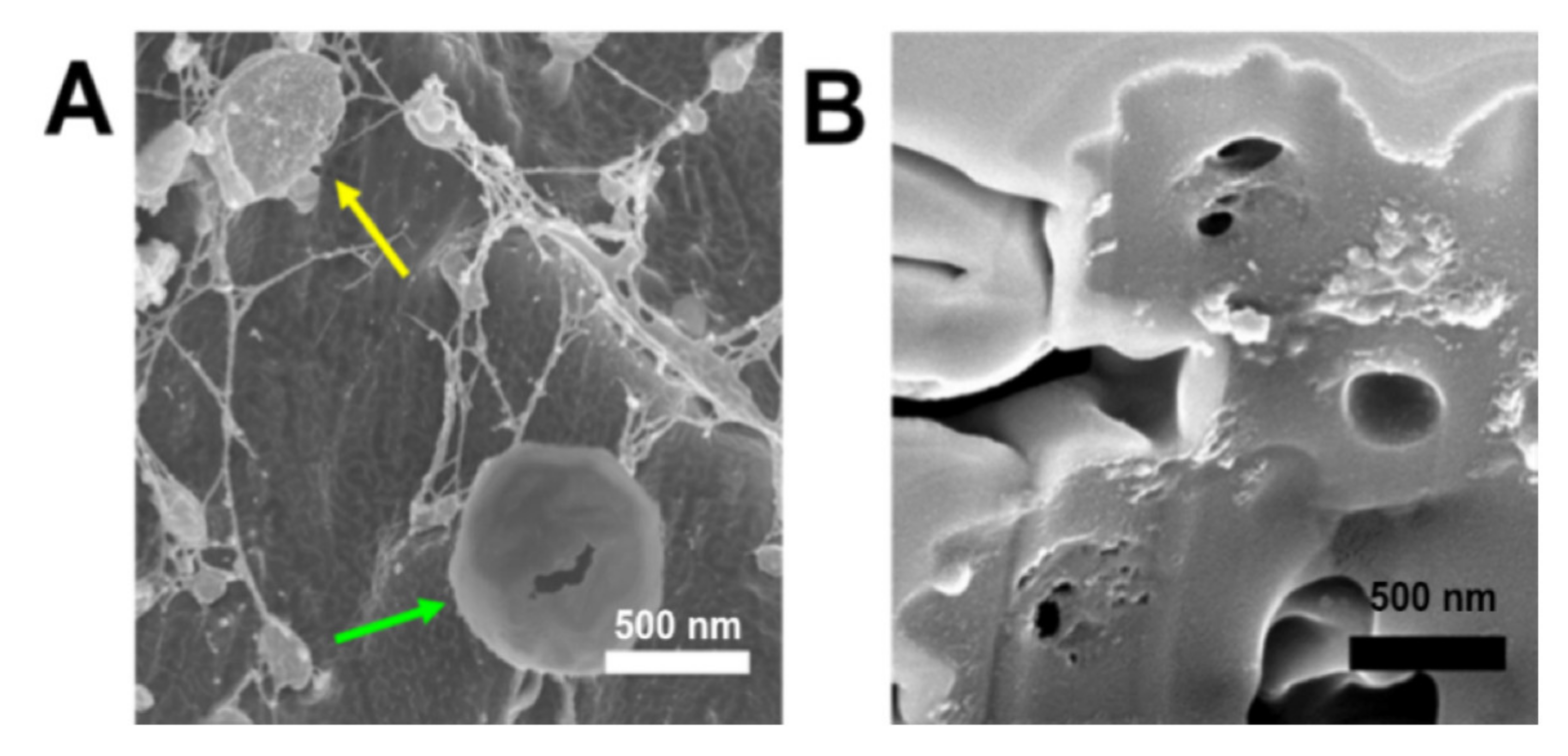Formation of Microcages from a Collagen Mimetic Peptide via Metal-Ligand Interactions
Abstract
:1. Introduction
2. Materials and Methods
2.1. Materials
2.2. General Peptide Synthesis
2.3. Circular Dichroism (CD)Spectroscopy
2.4. Dynamic Light Scattering (DLS)
2.5. Metal-Free Assembly into Disks and Domes
2.6. Metal-Promoted Microcage Formation
2.7. Atomic Force Microscopy (AFM)
2.8. Scanning Electron Microscopy (SEM) and Focused Ion Beam (FIB)
2.9. Cryogenic Scanning Electron Microscopy (SEM)
2.10. Confocal Microscopy
2.11. Encapsulation and Release Experiments
3. Results and Discussion
3.1. Synthesis of HByp4 and Confirmation of Triple Helix Formation
3.2. Dynamic Light Scattering Analysis of HByp4
3.3. Visualization of Assemblies Formed from HByp4 in the Absence of Metal
3.4. Characterization and Visualization of Metal-Promoted Supramolecular Assembly of HByp4
3.5. Encapsulation and Release of Dextrans from Microcages
4. Conclusions
Author Contributions
Funding
Conflicts of Interest
References
- Chattopadhyay, S.; Raines, R.T. Collagen-based Biomaterials for Wound Healing. Biopolymers 2014, 101, 821–833. [Google Scholar] [CrossRef] [PubMed] [Green Version]
- Strauss, K.; Chmielewski, J. Advances in the Design and Higher-Order Assembly of Collagen Mimetic Peptides for Regenerative Medicine. Curr. Opin. Biotechnol. 2017, 46, 34–41. [Google Scholar] [CrossRef] [PubMed]
- Jiang, F.; Hörber, H.; Howard, J.; Müller, D.J. Assembly of Collagen into Microribbons: Effects of pH and Electrolytes. J. Struct. Biol. 2004, 148, 268–278. [Google Scholar] [CrossRef]
- Kraskiewicz, H.; Breen, B.; Sargeant, T.; McMahon, S.; Pandit, A. Assembly of Protein-Based Hollow Spheres Encapsulating a Therapeutic Factor. ACS Chem. Neurosci. 2013, 4, 1297–1304. [Google Scholar] [CrossRef] [Green Version]
- Matsuhashi, A.; Nam, K.; Kimura, T.; Kishida, A. Fabrication of Fibrillized Collagen Microspheres with the Microstructure Resembling an Extracellular Matrix. Soft Matter 2015, 11, 2844–2851. [Google Scholar] [CrossRef] [PubMed]
- Zhang, W.; Wang, X.; Wang, J.; Zhang, L. Drugs Adsorption and Release Behavior of Collagen/Bacterial Cellulose Porous Microspheres. Int. J. Biol. Macromol. 2019, 140, 196–205. [Google Scholar] [CrossRef]
- Yeung, P.; Cheng, K.H.; Yan, C.H.; Chan, B.P. Collagen Microsphere Based 3D Culture System for Human Osteoarthritis Chondrocytes (HOACs). Sci. Rep. 2019, 9, 12453. [Google Scholar] [CrossRef]
- Rico-Llanos, G.A.; Borrego-González, S.; Moncayo-Donoso, M.; Becerra, J.; Visser, R. Collagen Type I Biomaterials as Scaffolds for Bone Tissue Engineering. Polymers 2021, 13, 599. [Google Scholar] [CrossRef]
- Luo, T.; Kiick, K.L. Collagen-Like Peptide Bioconjugates. Bioconjugate Chem. 2017, 28, 816–827. [Google Scholar] [CrossRef]
- Koide, T.; Homma, D.L.; Asada, S.; Kitagawa, K. Self-Complementary Peptides for the Formation of Collagen-like Triple Helical Supramolecules. Bioorganic Med. Chem. Lett. 2005, 15, 5230–5233. [Google Scholar] [CrossRef]
- Kotch, F.W.; Raines, R.T. Self-Assembly of Synthetic Collagen Triple Helices. Proc. Natl. Acad. Sci. USA 2006, 103, 3028–3033. [Google Scholar] [CrossRef] [Green Version]
- Krishna, O.D.; Kiick, K.L. Supramolecular Assembly of Electrostatically Stabilized, Hydroxyproline-Lacking Collagen-Mimetic Peptides. Biomacromolecules 2009, 10, 2626–2631. [Google Scholar] [CrossRef] [PubMed] [Green Version]
- Paramonov, S.E.; Gauba, V.; Hartgerink, J.D. Synthesis of Collagen-like Peptide Polymers by Native Chemical Ligation. Macromolecules 2005, 38, 7555–7561. [Google Scholar] [CrossRef]
- Sarkar, B.; O’Leary, L.E.R.; Hartgerink, J.D. Self-Assembly of Fiber-Forming Collagen Mimetic Peptides Controlled by Triple-Helical Nucleation. J. Am. Chem. Soc. 2014, 136, 14417–14424. [Google Scholar] [CrossRef]
- Parmar, A.S.; James, J.K.; Grisham, D.R.; Pike, D.H.; Nanda, V. Dissecting Electrostatic Contributions to Folding and Self-Assembly Using Designed Multicomponent Peptide Systems. J. Am. Chem. Soc. 2016, 138, 4362–4367. [Google Scholar] [CrossRef]
- McGuinness, K.; Nanda, V. Collagen Mimetic Peptide Discs Promote Assembly of a Broad Range of Natural Protein Fibers through Hydrophobic Interactions. Org. Biomol. Chem. 2017, 15, 5893–5898. [Google Scholar] [CrossRef]
- Yao, L.; He, M.; Li, D.; Liu, H.; Wu, J.; Xiao, J. Self-Assembling Bolaamphiphile-like Collagen Mimetic Peptides. New J. Chem. 2018, 42, 7439–7444. [Google Scholar] [CrossRef]
- Merg, A.D.; van Genderen, E.; Bazrafshan, A.; Su, H.; Zuo, X.; Touponse, G.; Blum, T.B.; Salaita, K.; Abrahams, J.P.; Conticello, V.P. Seeded Heteroepitaxial Growth of Crystallizable Collagen Triple Helices: Engineering Multifunctional Two-Dimensional Core-Shell Nanostructures. J. Am. Chem. Soc. 2019, 141, 20107–20117. [Google Scholar] [CrossRef]
- Merg, A.D.; Touponse, G.; van Genderen, E.; Blum, T.B.; Zuo, X.; Bazrafshan, A.; Siaw, H.M.H.; McCanna, A.; Brian Dyer, R.; Salaita, K.; et al. Shape-Shifting Peptide Nanomaterials: Surface Asymmetry Enables PH-Dependent Formation and Interconversion of Collagen Tubes and Sheets. J. Am. Chem. Soc. 2020, 142, 19956–19968. [Google Scholar] [CrossRef] [PubMed]
- Cejas, M.A.; Kinney, W.A.; Chen, C.; Vinter, J.G.; Almond, H.R.; Balss, K.M.; Maryanoff, C.A.; Schmidt, U.; Breslav, M.; Mahan, A.; et al. Thrombogenic Collagen-Mimetic Peptides: Self-Assembly of Triple Helix-Based Fibrils Driven by Hydrophobic Interactions. Proc. Natl. Acad. Sci. USA 2008, 105, 8513–8518. [Google Scholar] [CrossRef] [Green Version]
- McGuinness, K.; Khan, I.J.; Nanda, V. Morphological Diversity and Polymorphism of Self-Assembling Collagen Peptides Controlled by Length of Hydrophobic Domains. ACS Nano 2014, 8, 12514–12523. [Google Scholar] [CrossRef] [PubMed] [Green Version]
- Zhao, X.; Sun, H.; Zhang, X.; Ren, J.; Shao, F.; Liu, K.; Li, W.; Zhang, A. OEGylated Collagen Mimetic Polypeptides with Enhanced Supramolecular Assembly. Polymer 2016, 99, 281–291. [Google Scholar] [CrossRef]
- Cejas, M.A.; Kinney, W.A.; Chen, C.; Leo, G.C.; Tounge, B.A.; Vinter, J.G.; Joshi, P.P.; Maryanoff, B.E. Collagen-Related Peptides: Self-Assembly of Short, Single Strands into a Functional Biomaterial of Micrometer Scale. J. Am. Chem. Soc. 2007, 129, 2202–2203. [Google Scholar] [CrossRef] [PubMed]
- Koga, T.; Kingetsu, S.; Higashi, N. Supramolecular Nanofibers from Collagen-Mimetic Peptides Bearing Various Aromatic Groups at N-Termini via Hierarchical Self-Assembly. Int. J. Mol. Sci. 2021, 22, 4533. [Google Scholar] [CrossRef] [PubMed]
- Chen, C.-C.; Hsu, W.; Kao, T.-C.; Horng, J.-C. Self-Assembly of Short Collagen-Related Peptides into Fibrils via Cation—π Interactions. Biochemistry 2011, 50, 2381–2383. [Google Scholar] [CrossRef] [PubMed]
- Przybyla, D.E.; Chmielewski, J. Higher-Order Assembly of Collagen Peptides into Nano- and Microscale Materials. Biochemistry 2010, 49, 4411–4419. [Google Scholar] [CrossRef] [PubMed]
- Curtis, R.W.; Chmielewski, J. A Comparison of the Collagen Triple Helix and Coiled-coil Peptide Building Blocks on Metal Ion-mediated Supramolecular Assembly. Pept. Sci. 2021, 113, e24190. [Google Scholar] [CrossRef]
- Pires, M.M.; Chmielewski, J. Self-Assembly of Collagen Peptides into Microflorettes via Metal Coordination. J. Am. Chem. Soc. 2009, 131, 2706–2712. [Google Scholar] [CrossRef]
- Hsu, W.; Chen, Y.-L.; Horng, J.-C. Promoting Self-Assembly of Collagen-Related Peptides into Various Higher-Order Structures by Metal-Histidine Coordination. Langmuir 2012, 28, 3194–3199. [Google Scholar] [CrossRef]
- Strauss, K.; Chmielewski, J. Metal-Promoted Assembly of Two Collagen Mimetic Peptides into a Biofunctional “Spiraled Horn” Scaffold. Materials 2016, 9, 838. [Google Scholar] [CrossRef]
- He, M.; Wang, L.; Wu, J.; Xiao, J. Ln3+-Mediated Self-Assembly of a Collagen Peptide into Luminescent Banded Helical Nanoropes. Chem. Eur. J. 2016, 22, 1914–1917. [Google Scholar] [CrossRef] [PubMed]
- Pires, M.M.; Przybyla, D.E.; Rubert Pérez, C.M.; Chmielewski, J. Metal-Mediated Tandem Coassembly of Collagen Peptides into Banded Microstructures. J. Am. Chem. Soc. 2011, 133, 14469–14471. [Google Scholar] [CrossRef]
- Kotha, R.R.; Chmielewski, J. Controlling the Morphology of Metal-Triggered Collagen Peptide Assemblies through Ligand Alteration: Controlling the Morphology of Metal-Triggered Collagen Peptide. Biopolymers 2015, 104, 379–383. [Google Scholar] [CrossRef]
- Ting, Y.-H.; Chen, H.-J.; Cheng, W.-J.; Horng, J.-C. Zinc(II)-Histidine Induced Collagen Peptide Assemblies: Morphology Modulation and Hydrolytic Catalysis Evaluation. Biomacromolecules 2018, 19, 2629–2637. [Google Scholar] [CrossRef] [PubMed]
- Przybyla, D.E.; Chmielewski, J. Metal-Triggered Collagen Peptide Disk Formation. J. Am. Chem. Soc. 2010, 132, 7866–7867. [Google Scholar] [CrossRef] [PubMed]
- Przybyla, D.E.; Rubert Pérez, C.M.; Gleaton, J.; Nandwana, V.; Chmielewski, J. Hierarchical Assembly of Collagen Peptide Triple Helices into Curved Disks and Metal Ion-Promoted Hollow Spheres. J. Am. Chem. Soc. 2013, 135, 3418–3422. [Google Scholar] [CrossRef]
- Gleaton, J.; Chmielewski, J. Thermally Controlled Collagen Peptide Cages for Biopolymer Delivery. ACS Biomater. Sci. Eng. 2015, 1, 1002–1008. [Google Scholar] [CrossRef]
- Pires, M.M.; Przybyla, D.E.; Chmielewski, J. A Metal-Collagen Peptide Framework for Three-Dimensional Cell Culture. Angew. Chem. Int. Ed. 2009, 48, 7813–7817. [Google Scholar] [CrossRef]
- Hernandez-Gordillo, V.; Chmielewski, J. Mimicking the Extracellular Matrix with Functionalized, Metal-Assembled Collagen Peptide Scaffolds. Biomaterials 2014, 35, 7363–7373. [Google Scholar] [CrossRef]
- Sun, X.; He, M.; Wang, L.; Luo, L.; Wang, J.; Xiao, J. Luminescent Biofunctional Collagen Mimetic Nanofibers. ACS Omega 2019, 4, 16270–16279. [Google Scholar] [CrossRef] [PubMed] [Green Version]
- Persikov, A.V.; Xu, Y.; Brodsky, B. Equilibrium Thermal Transitions of Collagen Model Peptides. Protein Sci. 2004, 13, 893–902. [Google Scholar] [CrossRef] [PubMed] [Green Version]
- Hodges, J.A.; Raines, R.T. Stereoelectronic Effects on Collagen Stability: The Dichotomy of 4-Fluoroproline Diastereomers. J. Am. Chem. Soc. 2003, 125, 9262–9263. [Google Scholar] [CrossRef]
- Przybyla, D.E.; Chmielewski, J. Metal-Triggered Radial Self-Assembly of Collagen Peptide Fibers. J. Am. Chem. Soc. 2008, 130, 12610–12611. [Google Scholar] [CrossRef] [PubMed]
- Kar, K.; Ibrar, S.; Nanda, V.; Getz, T.M.; Kunapuli, S.P.; Brodsky, B. Aromatic Interactions Promote Self-Association of Collagen Triple-Helical Peptides to Higher-Order Structures. Biochemistry 2009, 48, 7959–7968. [Google Scholar] [CrossRef] [Green Version]
- Slatter, D.A.; Bihan, D.G.; Jarvis, G.E.; Stone, R.; Pugh, N.; Giddu, S.; Farndale, R.W. The Properties Conferred upon Triple-Helical Collagen-Mimetic Peptides by the Presence of Cysteine Residues. Peptides 2012, 36, 86–93. [Google Scholar] [CrossRef] [Green Version]
- Jiang, T.; Xu, C.; Liu, Y.; Liu, Z.; Wall, J.S.; Zuo, X.; Lian, T.; Salaita, K.; Ni, C.; Pochan, D.; et al. Structurally Defined Nanoscale Sheets from Self-Assembly of Collagen-Mimetic Peptides. J. Am. Chem. Soc. 2014, 136, 4300–4308. [Google Scholar] [CrossRef] [PubMed]
- Jiang, T.; Xu, C.; Zuo, X.; Conticello, V.P. Structurally Homogeneous Nanosheets from Self-Assembly of a Collagen-Mimetic Peptide. Angew. Chem. Int. Ed. Engl. 2014, 53, 8367–8371. [Google Scholar] [CrossRef] [PubMed]







Publisher’s Note: MDPI stays neutral with regard to jurisdictional claims in published maps and institutional affiliations. |
© 2021 by the authors. Licensee MDPI, Basel, Switzerland. This article is an open access article distributed under the terms and conditions of the Creative Commons Attribution (CC BY) license (https://creativecommons.org/licenses/by/4.0/).
Share and Cite
Gleaton, J.; Curtis, R.W.; Chmielewski, J. Formation of Microcages from a Collagen Mimetic Peptide via Metal-Ligand Interactions. Molecules 2021, 26, 4888. https://doi.org/10.3390/molecules26164888
Gleaton J, Curtis RW, Chmielewski J. Formation of Microcages from a Collagen Mimetic Peptide via Metal-Ligand Interactions. Molecules. 2021; 26(16):4888. https://doi.org/10.3390/molecules26164888
Chicago/Turabian StyleGleaton, Jeremy, Ryan W. Curtis, and Jean Chmielewski. 2021. "Formation of Microcages from a Collagen Mimetic Peptide via Metal-Ligand Interactions" Molecules 26, no. 16: 4888. https://doi.org/10.3390/molecules26164888




